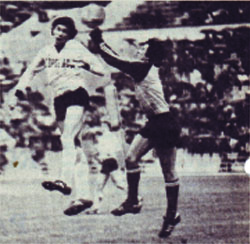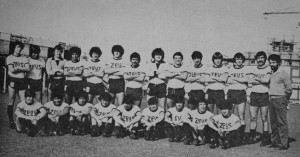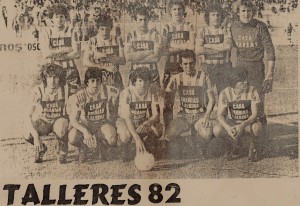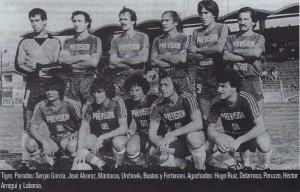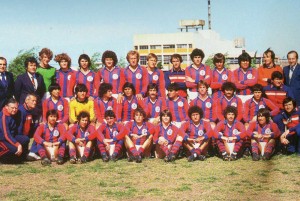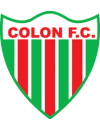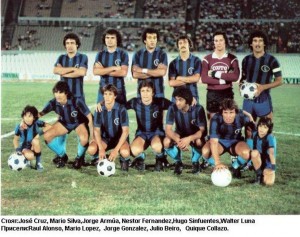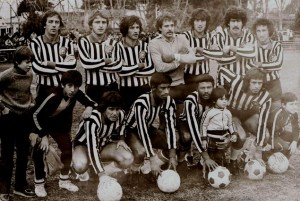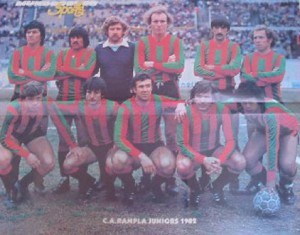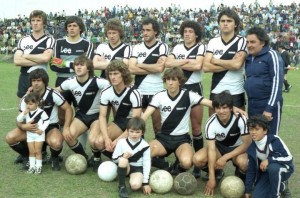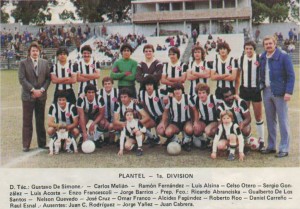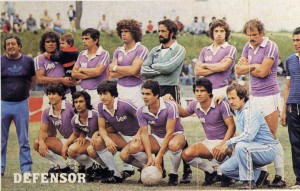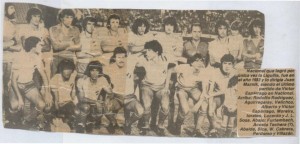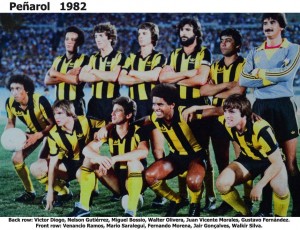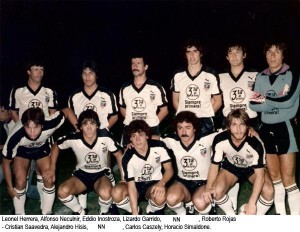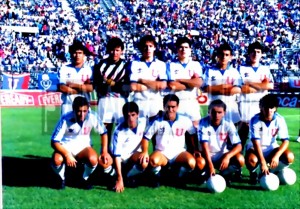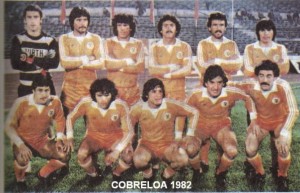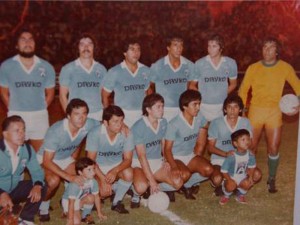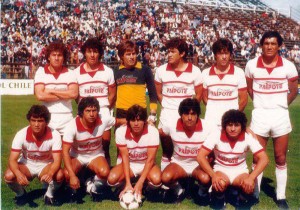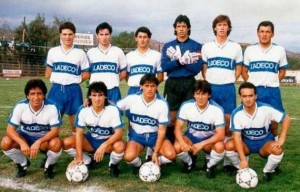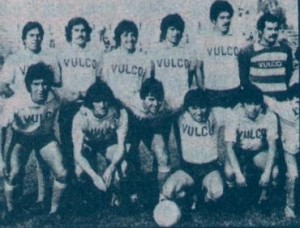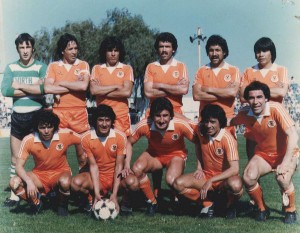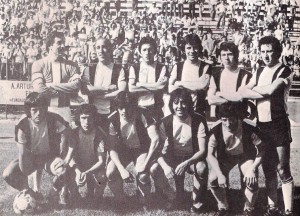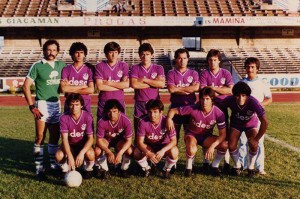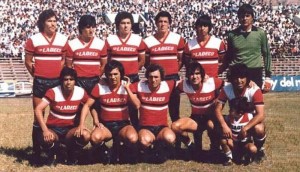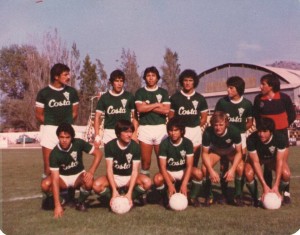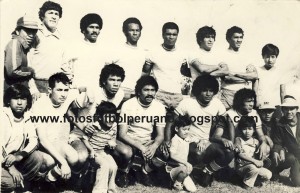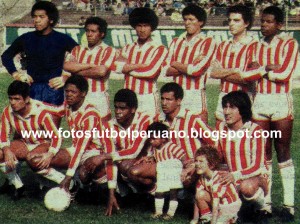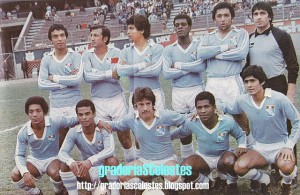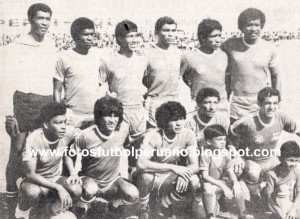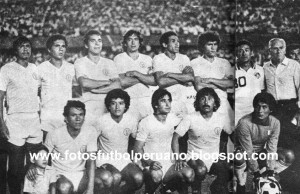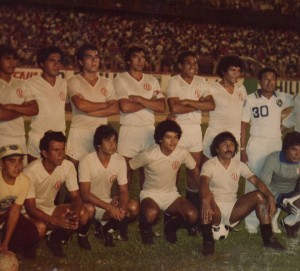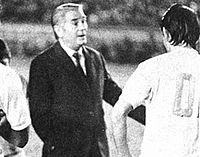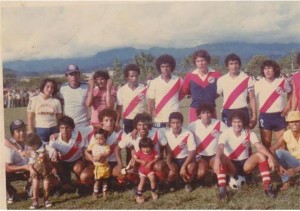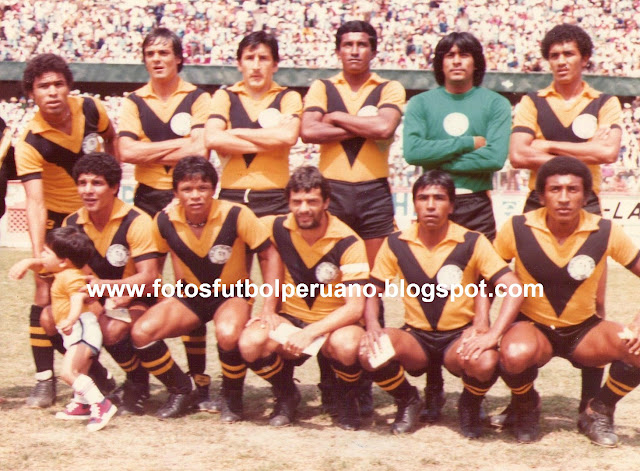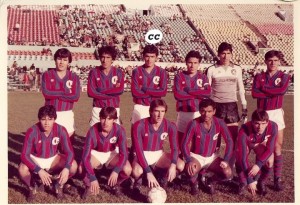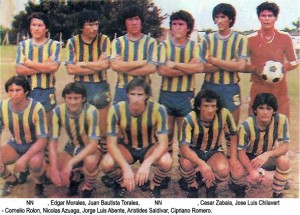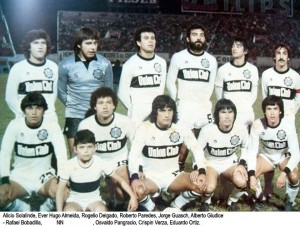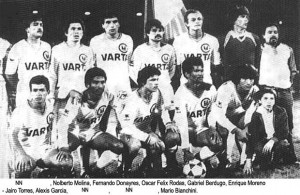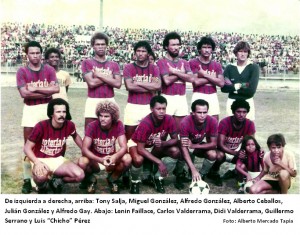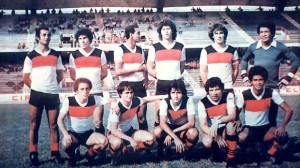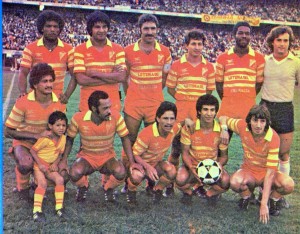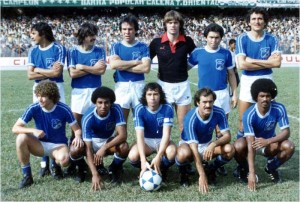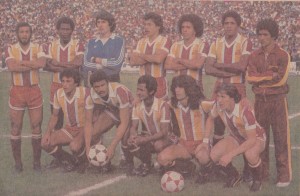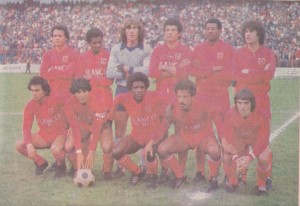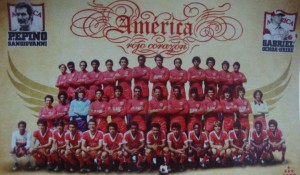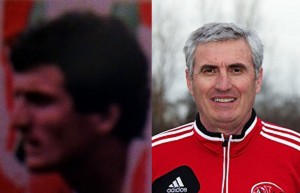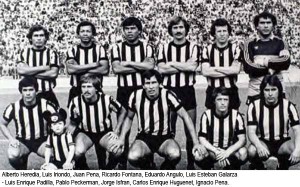The Championships – well, Argentina had two championships and champions for years: Nacional and Metropolitano. A few words before going into them. The 1982 World Cup may have been a disastrous factor, because the leading club performed poorly. The exodus of star players also affected the clubs, particularly Boca Juniors – Maradona moved to Spanish Barcelona. Not just River Plate and Boca Juniors had a weak year – all the big names underperformed: Independiente, Newell’s Old Boys, Velez Sarsfield, Huracan, Rosario Central, and no need to really mention Racing Club, which mostly struggled to survive ever since they lost so much money in 1967, their most triumphal year. Of course, it was not just the World Cup – Argentine football was in desperate financial situation for many years, corruption and mismanagement were the norm, and on top of that were the current and no longer new, but just deepening, political and economic difficulties of the country – so far, crowned by the fresh Malvinas Islands war. Well, when one suffers, another has the best of times.
Campeonato Nacional. The true national championship, to which regional clubs had a chance to rub shoulders with the big boys and, occasinally, even to outplay them. This year was not the year of the small fry, but the year of the very small fry, for many hardly ever heard of clubs not just qualified to play in the Nacional, but actually ruled it. Clubs, like
 Union San Vicente (Cordoba) – 7th in Group B. They were not alone – there were many: Guarani Antonio Franco (Posadas), Deportivo Roca (General Roca), and Renato Cesarini (Rosario) in Group D; Mariano Moreno (Junin) and Central Norte (Salta) in Group C; Estudiantes ( Santiago del Estero), San Lorenzo (Mar del Plata), and Atletico Concepcion (Banda del Rio Sali) in Group B; Independiente Rivadavia (Mendoza) in Group A. They all put some fight and inconvenienced the big clubs, of which only one emerged from the group stage: Estadiantes (La Plata). The rest were eliminated… Newell’s Old Boys was 3rd and River Plate 6th in Group A; Independiente – 3rd, and Argentinos Juniors – 4th in Group B; Rosario Central – 3rd, Boca Juniors – 4th, and Huracan 6th in Group C; Velez Sarsfield – 3rd and Racing Club – 8th and last in the table of Group D. Only Independiente was a bit unlucky of the big clubs – they failed to reach the next stage on worse goal-difference. Even the second-tier clubs were not particularly strong, although most of them took advantage of the weakness of the big clubs. So, to the next stage qualified: Quilmes (Quilmes) and Independiente Rivadavia (Mendoza) from Group A; Ferro Carril Oeste (Buenos Aires) and Union (Santa Fe) from Group B; Estudiantes (La Plata) and Talleres (Cordoba) from Group C; and Atletico Racing (Cordoba) and San Martin (Tucuman) from Group D.
Union San Vicente (Cordoba) – 7th in Group B. They were not alone – there were many: Guarani Antonio Franco (Posadas), Deportivo Roca (General Roca), and Renato Cesarini (Rosario) in Group D; Mariano Moreno (Junin) and Central Norte (Salta) in Group C; Estudiantes ( Santiago del Estero), San Lorenzo (Mar del Plata), and Atletico Concepcion (Banda del Rio Sali) in Group B; Independiente Rivadavia (Mendoza) in Group A. They all put some fight and inconvenienced the big clubs, of which only one emerged from the group stage: Estadiantes (La Plata). The rest were eliminated… Newell’s Old Boys was 3rd and River Plate 6th in Group A; Independiente – 3rd, and Argentinos Juniors – 4th in Group B; Rosario Central – 3rd, Boca Juniors – 4th, and Huracan 6th in Group C; Velez Sarsfield – 3rd and Racing Club – 8th and last in the table of Group D. Only Independiente was a bit unlucky of the big clubs – they failed to reach the next stage on worse goal-difference. Even the second-tier clubs were not particularly strong, although most of them took advantage of the weakness of the big clubs. So, to the next stage qualified: Quilmes (Quilmes) and Independiente Rivadavia (Mendoza) from Group A; Ferro Carril Oeste (Buenos Aires) and Union (Santa Fe) from Group B; Estudiantes (La Plata) and Talleres (Cordoba) from Group C; and Atletico Racing (Cordoba) and San Martin (Tucuman) from Group D.
In the ¼ finals Estudiantes, Ferro Carril Oeste, Talleres, and Quilmes eliminated their opponents, so at least a first division club was going to win the championship. Quilmes had the toughest time qualifying – they prevailed over Union only by penalty shoot-out.
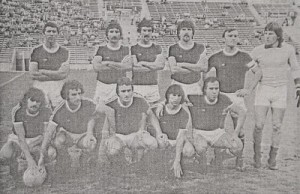 Here the march of Independiente Rivadavia ended, but the boys deserve a note – a small club, rarely, if at all, playing at big tournaments. They were 2nd – and that only because of worse goal-difference – in Group A, leaving behind Newell’s Old Boys, River Plate, and Instituto (Cordoba). They met Ferro Carril Oeste, historically, a weaker opponent than the clubs they already left in the dust, and were fairly equal – 0-0 and 0-1. An excellent season for this players!
Here the march of Independiente Rivadavia ended, but the boys deserve a note – a small club, rarely, if at all, playing at big tournaments. They were 2nd – and that only because of worse goal-difference – in Group A, leaving behind Newell’s Old Boys, River Plate, and Instituto (Cordoba). They met Ferro Carril Oeste, historically, a weaker opponent than the clubs they already left in the dust, and were fairly equal – 0-0 and 0-1. An excellent season for this players!
The semi-finals were the true end of the big clubs – Ferro Carril Oeste eliminated Talleres 4-0 and 4-4; and Quilmes won twice against Estudiantes – 2-0 and 1-0.
Unlikely final… Ferro Carril Oeste vs Quilmes. Old clubs, well known in Argentina, but more likely a third-tier clubs, although Quilmes was quite successful in the recent years, enjoying a good spell. So far, for very soon in this very year the spell was over. But at the moment there was no sigh of decline – Quilmes managed a 0-0 tie at the inhospitable stadium of Ferro Carril Oeste. The easiest part was coming – a home game. It was not easy at all – Ferro Carril Oeste won 2-0 and with this – the title.
Quilmes lost, but for this smallish club second place also equals success – vice-champions! Great! Standing from left: Clide Díaz, Tocalli, Milozzi, Gáspari, Zárate, Oscar Emilio Gizzi;
First row: Lorea, Frediani, Acevedo, Converti, Oscar Antonio Gissi.
Not a single big name, not even familiar names – a testimony of this Argentine season.
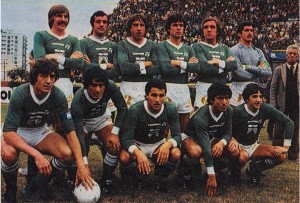 If Quilmes was happy with 2nd place, imagine the joy of the champions – Ferro Carril Oeste never won a title before. Standing from left: Carlos Arregui, Gómez, Garré, Cúper, Rocchia, Basigalup.
If Quilmes was happy with 2nd place, imagine the joy of the champions – Ferro Carril Oeste never won a title before. Standing from left: Carlos Arregui, Gómez, Garré, Cúper, Rocchia, Basigalup.
First row: Saccardi, Juárez, Márcico, Cañete, Crocco.
Unlike Quilmes, the champions had a star – not a first rate star, but still a star: Garre. He hardly made the whole difference, but was an advantage somewhat. Well, the real advantage was stronger squad, compared to the one Quilmes had. And what a moment they had! The club from the neighbourhood Caballito, Buenos Aires, was found in 1904 and to this moment their best triumphs were winning the Second Division. They did 6 times, most recently in 1978 – this is to say that first division football, let alone success, was rare thing for the club associated with railroad company at its birth. Their big triumph to date, a true success – champions at last! Yes, they beat just the ‘beermakers’, but first title is historic event for any club in the world. The big golden moment. And as a final note – in the early years their colours were maroon and lighblue – taken from Aston Villa, for the English influence was big: the railroad company was British at that time, so the first white kit with black socks was changed in 1907. In 1911 the colours were changed again and Ferro uses green and white to this very day (except 1974, when orange and white was used, paying tribute to the great Holland of that time). Hector Cuper and Alberto Marcico were the noticeable players of the golden generation, but Oscar Garre was the real stars – the defender was born in 1956 and played for Ferro from 1974 to 1988. He was included in the Argentine national team in 1983 and played a total of 39 matches for it in 5 years, becoming a world champion in 1986. But the real hero was the coach:
 Carlos Timoteo Griguol came in 1979 from lowly Kimberley, but he already had a strong reputation from winning the championship with Rosario Central in 1973 and working in Mexico after that. He was at the perfect coaching age – 46: still young, but with plenty of experience. Although one of the best coaches at the time, his name is quite unknown – the reason is he preferred conservative style and because of that he was never seriously considered a national team coach. Conservative or not, he made Ferro Carril Oeste champions for the first time in their history. He made them champions twice, but the second title was still in the unknown future, so let stay with the moment – nobody supporting Ferro will ever forget it.
Carlos Timoteo Griguol came in 1979 from lowly Kimberley, but he already had a strong reputation from winning the championship with Rosario Central in 1973 and working in Mexico after that. He was at the perfect coaching age – 46: still young, but with plenty of experience. Although one of the best coaches at the time, his name is quite unknown – the reason is he preferred conservative style and because of that he was never seriously considered a national team coach. Conservative or not, he made Ferro Carril Oeste champions for the first time in their history. He made them champions twice, but the second title was still in the unknown future, so let stay with the moment – nobody supporting Ferro will ever forget it.
